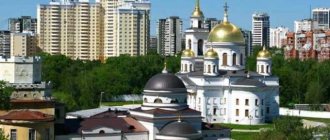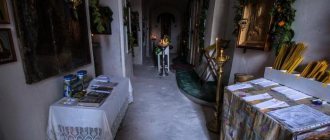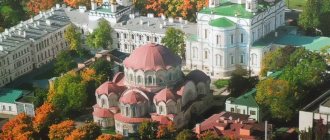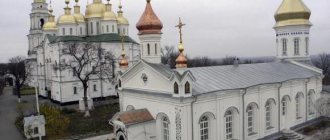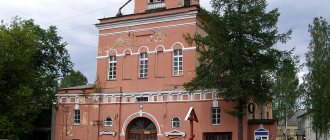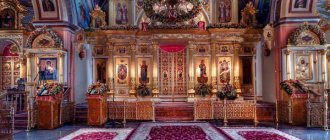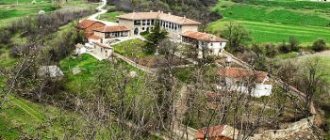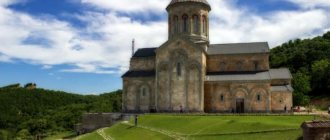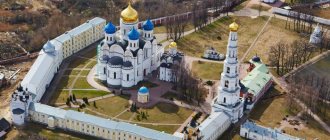Resurrection New Jerusalem Monastery
Founded in 1656 by Patriarch Nikon. The monastery reproduced on Russian soil the complex of holy places of Palestine so that believers could see them with their own eyes, without making a long and difficult trip. In the 17th century there were no photographs or reliable information about the Holy Land, but the monastery made it possible to touch the gospel history.
Abbots, governors
- Stephen (1656 - 1658)
- Gerasim (1658 - October 1665)
- Akakiy (December 25, 1666 - 1670)
- Theodosius (mentioned 1671)
- Philotheus (1672 - January 1680)
- Barsanuphius (February - October 25, 1680)
- Hermann I (1681 - 1682)
- Nikephoros (January 1683 - 1685)
- Nicanor (1685 - 1698)
- Herman II (October 13, 1698 - June 26, 1699)
- Arseny (July 30, 1699 - 1703)
- Ignatius (1703 - 1709)
- Anthony (1709 - 1722)
- Lavrenty (Gorka) (April 29, 1722 - September 8, 1723)
- Cyprian (Skripitsyn) (August 1723 - September 27, 1727)
- Melchizedek (Borshchov) (June 1727 - April 1736?)
- Karion (Golubovsky) (July 19, 1737 - 1742)
- Peter (Smelich) (September 6, 1742 - November 27, 1744)
- St. Hilarion (Grigorovich) (December 17, 1744 - May 22, 1748)
- Ambrose (Zertis-Kamensky) (May 10, 1748 - August 2, 1765)
- Nikon (Zertis-Kamensky) (August 2, 1765 - September 29, 1771)
- Sylvester (Stragorodsky) (1771 - October 3, 1785)
- Pavel (Ponomarev) (October 13, 1785 - January 14, 1786)
- Apollos (Baibakov) (1786 - 1788)
- Platon (Lyubarsky) (June 21, 1788 - March 31, 1792)
- Nektary (Chernyavsky) (March 31, 1792 - April 2, 1792) was appointed, but died
- Varlaam (Golovin) (April 13, 1792 - January 17, 1799)
- Jerome (Poniatowski) (January 17, 1799 - June 4, 1802)
- Gideon (Ilyin-Zamatsky) (July 19, 1802 - August 20, 1805)
- Melchizedek (Minervin) (September 25, 1805 - June 29, 1813)
- Jonah (Pavinsky) (December 31, 1813 - July 22, 1817)
- Filaret (Amphitheaters) (July 28, 1817 - June 1, 1819)
- Afanasy (Telyatev) (October 30, 1819 - March 10, 1821)
- Apollos (Alekseevsky) (February 9, 1821 - February 19, 1837)
- Arseny (Nagibin) (February 19, 1837 - 1838?)
- Agapit (Voznesensky) (June 10, 1841 - March 2, 1850)
- Melchizedek (Sokolnikov) (March 26, 1851 - 1852)
- Kliment (Mozharov) (1852 - 1856)
- Amfilohiy (Sergievsky-Kazantsev) (July 28, 1858 - 1860)
- Dionysius (Dolgopolov) (May 25, 1860 - January 1862)
- Anthony (Radonezh) (March 17, 1862 - May 11, 1866)
- Peter (Ekaterinovsky) (October 13, 1867 - April 4, 1869)
- Leonid (Kavelin) (1869 - 1877)
- Christopher (Smirnov) (December 13, 1890 - 1892)
- Andrey (Sadovsky) (April 26, 1893 - March 14, 1898)
- Vladimir (Philanthropov) (1898 - 1904)
- Seraphim (Chichagov) (1904 - 1905)
- Justin (Okhotin) (March 29, 1905 - May 25, 1907)
- sschmch. Tikhon (Nikanorov) (1907 - 1911)
- sschmch. Jonah (Lazarev) (March 22, 1911 - 1918)
- Trifon (Turkestanov) (June 2, 1916 - April 1, 1918) manager, bishop. b. Dmitrovsky
Since July 18, 1994, the monastery has been under the canonical control of the Patriarch of Moscow and All Rus' (stauropegia).
Viceroys
- Nikita (Latushko) (July 18, 1994 - June 23, 2008)
- Feofilakt (Bezukladnikov) (from (May 6) June 23, 2008)
Resurrection Cathedral
A copy of the Church of the Holy Sepulcher. The main feature of the cathedral is the rotunda. In its center, above the place depicting the burial place of the Savior, there is a small chapel - a cuvuklia (on the headpiece of the material). In it - just like in Jerusalem - there is a copy of the stone on which the body of Christ was laid. And in the Resurrection Cathedral there is a separate temple on the second floor, approximately at the place where Calvary - the Mount of the Crucifixion - was located.
During the Great Patriotic War, the monastery was almost completely destroyed - this was later a separate charge against a group of former leaders of the Third Reich at the Nuremberg Tribunal. The restoration of the monastery began already in 1942, and was completed only in 2019. Monastic life was revived here in 2008.
Brief history of the monastery
The foundation of the monastery was carried out on a hill with the Palestinian name Zion. On the eastern side, the Hill of Olives was adjacent to the monastery, its northern “neighbor” was the Tabor Hill, and the local Istra River received a new name - Jordan.
Bird's eye view of the monastery
Due to the persecution of Nikon and his exile, construction work was interrupted for 14 years. Thus, they took place in 2 stages. The first period of construction occurred between 1656 and 1666. At this time, wooden walls were installed, stone services were built, and the construction of the main temple was almost completed. The same period of time saw the construction of the Nikon monastery, which was later called the Waste Hermitage, and the Chapel of Olives.
View of the monastery from the village of Nikulino
Since 1679, the interrupted work has been resumed - Tsar Fyodor Alekseevich issued a corresponding decree on their continuation. In addition, by a new decree, the ruler assigned two dozen more different monasteries with peasant households to the New Jerusalem Monastery, the total number of which was 1,630 buildings. Together, they formed a huge possession and made the stauropegic monastery one of the richest shrines in Russia.
Nikon's plan was fully realized, and ultimately it amazed with its scope. The complex called “New Jerusalem” maximally reflected the Holy Lands, parts of which the entire area of Istra received new names - Galilee, Bethlehem, Olivet. When studying old maps, it is clear that the new building with its surrounding environs is a smaller copy of its true prototype. Unfortunately, the founder of the monastery did not wait for the completion of construction - he died in 1681. Subsequently, the ensemble was completed under the leadership of Archimandrite Nikanor and with the participation of the master foundry hieromonk Sergius Turchaninov.
View of the main entrance to the monastery
In the winter of 1941, the Resurrection Cathedral at the New Jerusalem Monastery was destroyed by German troops. As a result of the explosion, the bell tower, the central chapter, and the rotunda tent were damaged. Many years later, already in 1985, the cathedral finally found its lost chapter. As for the collapsed tent, it was restored in the early 90s of the 20th century. But its basis was now a metal structure.
Since 1995, the entire architectural ensemble of the Resurrection Monastery has become part of the Russian Orthodox Church. Since then, two institutions have peacefully coexisted here - the stauropegic monastery itself and the New Jerusalem Museum, recognized as a historical, architectural and artistic monument.
View of the Gate Church of the Entry of the Lord into Jerusalem from the monastery
Savvino-Storozhevsky Monastery Novorizhskoe Highway
The Savvino-Storozhevsky Monastery was founded in 1398 near Zvenigorod (50 km from Moscow) on the high bank of the river. Moscow on Mount Storozhe, which was a defensive fortification of the Moscow Principality. It was founded by the Monk Savva, the Zvenigorod wonderworker, one of the first disciples of the Monk Sergius of Radonezh, at the request of the Zvenigorod Prince Yuri Dmitrievich, the second son of the Great Moscow Prince Dimitri Donskoy. There were two main construction periods in the history of the monastery: the first - from the end of the 14th to the beginning of the 17th century, the second - the middle of the 17th - 19th centuries.
Initially, a small wooden church of the Nativity of the Blessed Virgin Mary and a cell attached to it were built. The good fame about the life of the Zvenigorod abbot spread far and wide, and monks flocked to the monastery, seeking spiritual guidance. New cells were built. The monastery was surrounded by a wooden fence with a gate on the north side.
Prince Yuri Dmitrievich of Zvenigorod revered the Monk Savva and patronized the monastery. The prince received the saint's blessing for a long military campaign against the Kama Bulgars and, according to the prediction of the Monk Savva, returned victorious. In gratitude, villages and hamlets in Zvenigorod and Ruza districts were given to the monastery for the establishment of the monastery.
Around 1405, the white-stone Nativity Cathedral was built, at the entrance to which in 6915 (according to modern chronology - 1406/1407) the Monk Savva, canonized at the Makarievsky Cathedral of 1547, was buried.
To the north of the cathedral you can see the foundations of ancient buildings. During excavations 1955–1957. managed to find out that at the beginning of the 16th century. Prince Yuri Ivanovich of Zvenigorod built the Holy Gate with a temple in the name of St. Sergius of Radonezh and a refectory on this site. Restorers have uncovered the apse of the temple and one-fourth of the basement floor of the refectory.
The church and refectory, which suffered during the Troubles, were dismantled during the renovation of the monastery in the middle of the 17th century.
At the beginning of the 17th century. The monastery was damaged during the Polish-Lithuanian intervention. “The Monastery of the Most Pure Mother of God and the monastic villages were destroyed, the monastery’s treasury money and horses and all sorts of monastic supplies and bread were taken, abbot Isaiah and his brethren were fenced off and burned with fire.” The monastery and the Zvenigorod district were plundered by the troops of two impostors - False Dmitry I and False Dmitry II, as well as the Polish prince Vladislav.
The monastery began to be revived already under the first Tsar from the Romanov dynasty - Mikhail Fedorovich and his father Patriarch Filaret, who came on pilgrimage to the “House of the Most Pure One on the Watchman” and through the prayers of St. Savvas received healing from their ailments.
In 1650, Tsar Alexei Mikhailovich issued a decree on the construction of a new monastery ensemble on Mount Storozhe, which began the second construction period in the monastic history. Already in the spring - autumn of 1649, the necessary construction work was carried out in the Nativity Cathedral and the paintings were done anew on a golden background.
In 1650–1656 The main buildings and fortress walls were built (length 760 m, height 8–9 m, thickness - about 3 m) with 7 towers, of which six have survived to this day. Temples were built in the monastery fence: the gate temple in the name of St. Sergius of Radonezh (1651–1652), later reconsecrated in honor of the Life-Giving Trinity; Preobrazhensky (second half of the 17th century), as well as the belfry and the Refectory Chamber (1650s), the Tsar's Palace and the Tsarina's Chambers (1650s), the Brotherhood and Cell buildings and other buildings.
Tsar Alexei Mikhailovich often visited the monastery in his youth, but regular royal pilgrimages to the monastery on Storozhi began in 1649. The second tsar from the Romanov dynasty chose the monastery as his residence. Monastic tradition explains his special zeal for the monastery by the miraculous intercession of the Zvenigorod wonderworker - the salvation of the king while hunting from a fierce bear.
One of the most important events of the reign of Alexei Mikhailovich was the discovery of the honest relics of St. Savva of Storozhevsky, which took place on January 19 (February 1 - new style) 1652. In memory of this event, which was witnessed by hundreds of the first people of the state, as well as numerous brethren of the monastery, by royal decree, it was cast by master I. Falk at the Moscow Cannon Yard The Annunciation Bell (more than 1344 poods), the fate of which is unknown. In memory of another event - the church council that condemned Patriarch Nikon - a new Blagovestnik (more than 2125 pounds) was cast by the “sovereign cannon and bell maker” Alexander Grigoriev.
Under Tsar Alexei Mikhailovich, the monastery became a Lavra and was subordinated to the personal office of the tsar, the order of Secret Affairs. According to the charter, it was equated to the Trinity-Sergius Monastery. 19 monasteries were assigned to the Savvino-Storozhevsky Monastery.
In 1764, all land holdings of the monastery were subject to secularization. It was ranked as a first class monastery with a staff of 33 monks.
During the Patriotic War of 1812, a battle was given to the enemy near the monastery, which delayed the advance of the French troops towards Moscow for 6 hours. From August 31 to October 15, 1812, the monastery was occupied by the enemy.
Thanks to the miraculous intercession of the Monk Savva - the appearance of the Zvenigorod saint to the commander of the 4th corps of the French army, Viceroy of Italy Eugene Beauharnais - the holy relics remained intact, although the monastery was seriously damaged during the enemy invasion.
After the war, the monastery was revived, including through generous royal donations. In 1839, Emperor Nicholas I and the Grand Dukes visited him, and later Emperor Alexander II the Liberator visited him several times.
In 1898, the 500th anniversary of the Savvino-Storozhevsky Monastery was solemnly celebrated.
In 1995, the monastery was revived. During the celebration of the 600th anniversary of the monastery in 1998, His Holiness Patriarch Alexy II solemnly transferred the relics of St. Savva to it.
Currently, there are 30 monks and novices in the Savvino-Storozhevsky Monastery. Divine services are performed not only in the monastery itself, but also in 11 churches attached to the monastery, located in Moscow, Zvenigorod, Kubinka (Odintsovo district), the villages of Savvinskaya Sloboda, Ershovo, Molzino (Noginsk district of the Moscow region). Through the labors of the monks, the monastery churches are being revived, the palace of Tsar Alexei Mikhailovich, the belfry, the fortress walls and towers are being restored. The monastery has an orphanage, two-year theological courses for adults, and a library with a reading room, the collections of which amount to 6.5 thousand volumes.
Where is the sacred monastery located?
Full address: st. Sovetskaya 2, Istra, Moscow region (New Jerusalem Monastery). Anyone can get to the community itself in several ways.
By shuttle bus: from the Tushino metro station to Istra, bus number 372 departs and runs to the stop called “Mail”. The entire journey takes about an hour.
How to get there by train
departs from the Kursky/Rizhsky station or you can go from the Tushino platform (not far from which the metro station of the same name is located). At the same time, the fare from the Tushino platform will be slightly less than that of electric trains departing from the station, but it should be taken into account that in the summer, due to summer residents, the trains may be overcrowded. You need to go to the Istra or New Jerusalem platform. After which you need to walk for 20 minutes (approximately 2 km), or take a bus to the “Monastery” stop;
The best article for you, go to: Iversky Monastery in Valdai
By car
along the Novorizhskoe/Volokolamskoe highway (about 45 km from the Moscow Ring Road), and then through the regional center of Istra to the New Jerusalem Monastery.
May the Lord protect you!
You will also be interested in watching a video about the monastery in Istra:
Patronal holidays[edit]
Resurrection of Christ (Easter)
— Rolling date
Nativity
- Jan. 7
Entry of the Lord into Jerusalem
— Sunday before Easter
Constantine and Helen, Equal to the Apostles
— June 3
Schedule of services
Services are held in the men's monastery according to the following schedule:
Monday. Fifth Week of Great Abstinence. St. Benedict of Nursia:
- 8 am – morning, hours with the recitation of the Holy Scriptures;
- 5 pm – Vespers, Great Compline.
The best article for you, go to: Women's St. Iveron Monastery Rostov-on-Don
Tuesday. Mch. Agapius and the seven great martyrs: two Dionysius, Alexander, Puplius, Romilus and Timolaus:
- 8 am – morning, hours with the recitation of the Holy Scriptures;
- 5 pm – Vespers, Great Compline.
Wednesday. St. Alexia, man of the Lord:
- 8 am – morning, hours, fine, evening, chanting of the Gifts of the Presanctified;
- 5 pm – Matins with the saying of the great prayer service to St. Andrew of Crete.
Thursday. St. Makariy Kalyazinsky:
- 8 a.m. – chanting the Gifts of the Pre-Illuminated;
- 5 pm – Vespers, Great Compline.
Friday. Jerusalem Archbishop St. Kirill (those who are preparing to celebrate the Holy Sacrament of Communion should abstain from eating for 6 hours):
- 8 am – morning, hours from the recitation of the Holy Scriptures;
- 5 pm – Great Compline, singing of the Gifts of the Presanctified.
Saturday. Reading akathists on Saturday. Offering praise to the Queen of Heaven:
- 8 am – morning with akathist chant, spiritual chant;
- 5 pm – all-night vigil.
Sunday. Fourth week of the Great Abstinence. St. John Climacus.
- 7 am – hours, early chant;
- 10 am – late church hymn;
- 5 pm – passion and evening.
- 5 pm - ritual of the sacrament.
Pilgrim[edit]
The Resurrection New Jerusalem Monastery invites Orthodox pilgrims to take part in monastic services, venerate the shrines, and get acquainted with the ancient history of the monastery and its spiritual heritage.
Divine services[edit]
Current schedule of services
In the Holy Resurrection New Jerusalem Stavropegic Monastery, the following Sacraments and services are performed daily:
- Sacrament of Baptism.
- The Sacrament of Wedding (on the days prescribed by the Church).
- Confession, Unction, Communion at home, consecration of homes and cars.
- Funeral service (in absentia and in person).
- Consecration of crosses and icons.
You can order Sacraments and services in a candle box or by phone:
; 4-71-70
There are no fees for performing the Sacraments and requirements. Those wishing to make a donation are asked to put money into the monastery mug themselves.
Excursions[edit]
Anyone wishing to visit the monastery on a tour can sign up by calling:
8-(498)-314-68-38 from 9.00 to 18.00 and 8-(910)-461-18-57.
The monastery's pilgrimage service is located on the territory of the monastery.
Attention! Not to be confused with the ticket office of the New Jerusalem Museum!
Registration can also be done by email:
and
via Skype
newj-palomnik.
When booking online, the excursion is considered booked only after you receive confirmation by email!
Ticket prices:
Single ticket including admission to all permanent exhibitions of the museum
- citizens of the Russian Federation - 500 rubles.
- preferential categories (schoolchildren, students, pensioners - 40% discount) - 300 rubles.
- foreign citizens - 600 rubles.
Temporary exhibitions
- citizens of the Russian Federation - from 150 rubles.
- preferential categories (schoolchildren, students, pensioners - 50% discount) - from 75 rubles.
- foreign citizens - from 210 rubles.
You can find out more on the official website: https://njerusalem.ru/
Architectural ensemble
Adjacent to the main temple on the eastern side is the underground church of Constantine and Helena. After all, New Jerusalem in the Moscow region, in its layout, resembles a complex in Palestine, and there this temple is carved out of the rock. The church is decorated in Baroque style. Its copper iconostasis is especially famous. The church also has a “Life-Giving Spring” treasury. Before the war, there was a bell tower next to the cathedral, which was destroyed during hostilities. But in two thousand and fourteen it was restored. New bells were also cast. Historical premises have also been preserved on the territory of the monastery, such as the chambers of Princess Tatyana Mikhailovna. The monastery is surrounded by a fortress wall up to three meters thick and about a kilometer long. The structure was intended for defensive operations. Along the perimeter of the wall there is a walkway between the rows of loopholes. All the towers of the wall also have “Palestinian” names.
